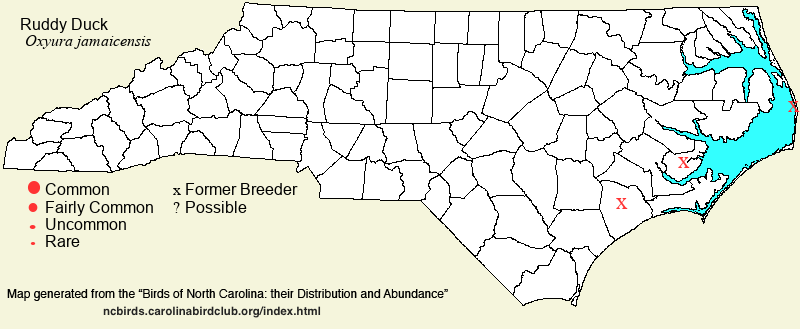 |  |
|
Ruddy Duck - Oxyura jamaicensis ANATIDAE Members: | Search Common: Search Scientific: |
|
|
|||||||
| General Comments | This reasonably tame duck occurs in large numbers in winter in the state, though (as with most waterfowl species) more frequently in coastal areas. Ruddy Ducks often occur in tight, dense flocks, but it has a tendency to be somewhat local, especially on inland lakes. A handful of birds over-summer in the state, mostly near the coast, and conclusive breeding has been documented on at least two occasions. It shows little favoritism regarding fresh and salt water in its winter habitats. It is found widely on embayed rivers such as the lower Neuse and Pamlico rivers, Pamlico Sound (though not normally in the open center of the bay), and other bays. But, large numbers also winter on refuge impoundments (such as at Bodie and Pea islands), lakes, and ponds, both coastally and well inland. | ||||||
| Breeding Status | Accidental Breeder | ||||||
| NC BRC List | Definitive | ||||||
| State Status | |||||||
| U.S. Status | |||||||
| State Rank | S5N | ||||||
| Global Rank | G5 | ||||||
| Coastal Plain | Winter resident, and accidental breeder. In winter, common to locally abundant in the Tidewater and northern coastal areas; common along the southern coast. Farther inland, it is local, being uncommon to locally common on lakes and ponds. Generally late Oct to mid-Apr. Two pairs nested at Pea Island in 1953 (Pearson et al., 1959); and it has bred at Pamlico Point impoundments (Pamlico), at least in 1969 [Chat 34:92 link]. Birds can remain in some areas all summer, such as at the Goldsboro sewage treatment plant, but no further conclusive nesting has been documented. Peak counts: 12,000, lower Neuse River (Craven), 8 Mar 1981; 9,000, Lake Mattamuskeet, 20-31 Oct 1995; inland peak count -- 1,000 at Goldsboro on 21 Jan 2016. | ||||||
| Piedmont | Winter resident. Uncommon to locally common, more frequent in the eastern portions of the province, such as lakes and ponds in Wake; mainly early Nov to mid-Apr. A handful of summer records, but no evidence of breeding in the province. Peak counts: ? | ||||||
| Mountains | Transient and winter visitor. Generally rare in midwinter, and rare to uncommon in migration; mainly on lakes and ponds at low elevations in the southern mountains. Mainly early Nov to mid-Apr. Peak count: 11, Lake Toxaway, 1 Jan 1997. | ||||||
| Finding Tips |
The species can almost always be seen in winter at coastal NWR's such as Pea Island and Mattamuskeet. The Pamlico River and Neuse River ferries often encounter them. Some inland reservoirs, such as Lake Crabtree, are also consistently good for them. **** | ||||||
| Attribution | LeGrand[2023-03-02], LeGrand[2016-09-28], LeGrand[2013-12-08] | ||||||
| NC Map Map depicts all counties with a report (transient or resident) for the species. | Click on county for list of all known species. |
| NC Breeding Season Map Map depicts assumed breeding season abundance for the species. |  |